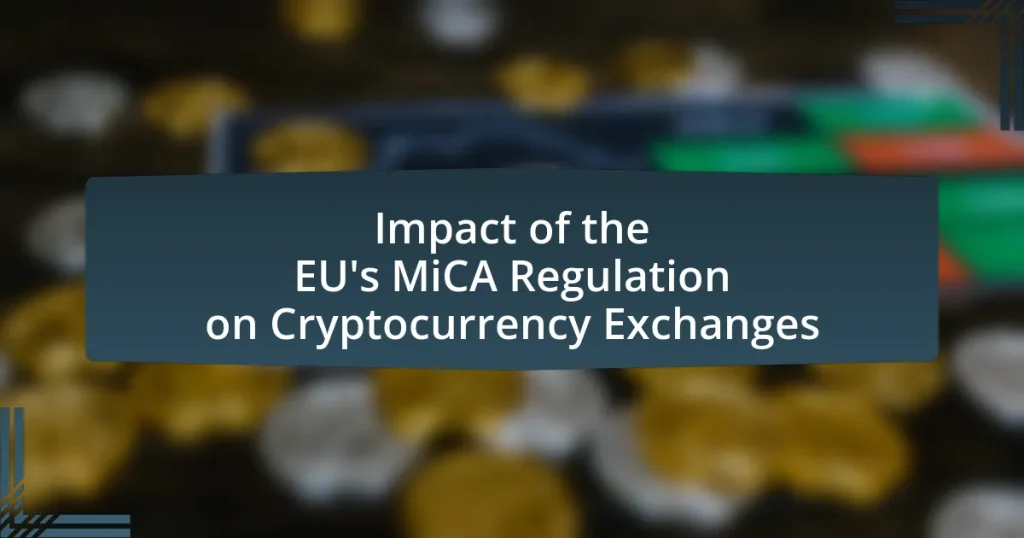The EU’s MiCA Regulation, or Markets in Crypto-Assets Regulation, establishes a comprehensive framework for regulating cryptocurrency exchanges within the European Union. It mandates that these exchanges, classified as crypto-asset service providers, obtain licenses, comply with anti-money laundering requirements, and ensure transparency in their operations. The regulation impacts various types of exchanges, including centralized, decentralized, and hybrid platforms, by imposing strict compliance and reporting obligations aimed at enhancing consumer protection and market integrity. Additionally, MiCA is expected to influence the competitive landscape of cryptocurrency exchanges, promote innovation, and increase investor confidence in the digital asset market.

What is the EU’s MiCA Regulation and its relevance to Cryptocurrency Exchanges?
The EU’s MiCA Regulation, or Markets in Crypto-Assets Regulation, is a comprehensive legislative framework aimed at regulating cryptocurrency markets within the European Union. Its relevance to cryptocurrency exchanges lies in the establishment of clear rules and standards for the operation of these platforms, ensuring consumer protection, market integrity, and financial stability. MiCA mandates that cryptocurrency exchanges obtain licenses to operate, adhere to anti-money laundering (AML) requirements, and provide transparency regarding their operations and the assets they offer. This regulatory framework is designed to foster innovation while mitigating risks associated with the volatility and potential misuse of cryptocurrencies, thereby enhancing trust in the digital asset ecosystem.
How does the MiCA Regulation define cryptocurrency exchanges?
The MiCA Regulation defines cryptocurrency exchanges as platforms that facilitate the exchange of cryptocurrencies for other digital assets or fiat currencies. Specifically, these exchanges are categorized as “crypto-asset service providers” (CASPs) under the regulation, which mandates that they must register and comply with regulatory requirements to operate legally within the EU. This definition is crucial as it establishes the framework for oversight and consumer protection in the rapidly evolving cryptocurrency market.
What types of cryptocurrency exchanges are impacted by the MiCA Regulation?
The MiCA Regulation impacts centralized exchanges, decentralized exchanges, and hybrid exchanges. Centralized exchanges, which facilitate trading through a third party, must comply with licensing and operational requirements set by the regulation. Decentralized exchanges, operating without a central authority, are also affected as they must adhere to rules regarding consumer protection and anti-money laundering. Hybrid exchanges, combining features of both centralized and decentralized platforms, face similar regulatory obligations. This comprehensive approach ensures that all types of exchanges maintain transparency and security in their operations.
What are the key terms and concepts introduced by the MiCA Regulation?
The key terms and concepts introduced by the MiCA Regulation include “crypto-assets,” “issuers,” “service providers,” and “stablecoins.” Crypto-assets refer to digital representations of value or rights that can be transferred and stored electronically. Issuers are entities that create and offer crypto-assets to the public, while service providers encompass businesses that facilitate the exchange, custody, or management of these assets. Stablecoins, a specific type of crypto-asset, are designed to maintain a stable value by pegging them to traditional currencies or commodities. These definitions establish a regulatory framework aimed at enhancing transparency and consumer protection in the cryptocurrency market.
What are the main objectives of the MiCA Regulation?
The main objectives of the MiCA Regulation are to establish a comprehensive regulatory framework for cryptocurrencies and to enhance consumer protection within the European Union. MiCA aims to provide legal clarity for crypto-assets, ensuring that issuers and service providers adhere to standardized rules, which promotes market integrity and reduces risks associated with fraud and market manipulation. Additionally, the regulation seeks to foster innovation in the financial sector while ensuring that financial stability is maintained, as evidenced by the European Commission’s proposal to regulate crypto-assets in response to the growing market and associated risks.
How does the MiCA Regulation aim to enhance consumer protection?
The MiCA Regulation aims to enhance consumer protection by establishing a comprehensive legal framework for cryptocurrency markets, ensuring transparency and accountability. It mandates that cryptocurrency service providers disclose essential information about their operations, including risks associated with digital assets, thereby enabling consumers to make informed decisions. Additionally, the regulation introduces licensing requirements for service providers, which helps to ensure that only compliant entities operate in the market, reducing the risk of fraud and protecting consumers’ interests.
What role does the MiCA Regulation play in promoting market integrity?
The MiCA Regulation plays a crucial role in promoting market integrity by establishing a comprehensive regulatory framework for cryptocurrency markets within the European Union. This regulation aims to enhance transparency, protect investors, and mitigate risks associated with market manipulation and fraud. By requiring cryptocurrency service providers to adhere to strict operational standards, including licensing and compliance obligations, MiCA fosters a more secure trading environment. Furthermore, it mandates clear disclosure of information to consumers, which helps in building trust and confidence in the market. The implementation of these measures is expected to reduce instances of misconduct and promote fair competition among market participants.

How will the MiCA Regulation affect the operations of cryptocurrency exchanges?
The MiCA Regulation will significantly impact the operations of cryptocurrency exchanges by imposing comprehensive regulatory requirements. Cryptocurrency exchanges will need to comply with licensing obligations, ensuring they meet capital requirements and adhere to anti-money laundering (AML) and consumer protection standards. This regulation aims to enhance transparency and security in the crypto market, which will require exchanges to implement robust compliance frameworks and reporting mechanisms. As a result, exchanges may face increased operational costs and administrative burdens to align with these new legal standards, ultimately shaping their business models and market strategies.
What compliance requirements must cryptocurrency exchanges meet under MiCA?
Cryptocurrency exchanges must meet several compliance requirements under the Markets in Crypto-Assets (MiCA) regulation, including obtaining a license from the relevant national authority, implementing anti-money laundering (AML) and counter-terrorism financing (CTF) measures, and ensuring consumer protection through transparency and disclosure obligations. Specifically, exchanges are required to provide clear information about the risks associated with crypto-assets, maintain adequate capital reserves, and adhere to operational and governance standards. These requirements aim to enhance market integrity and protect investors, as outlined in the MiCA framework established by the European Union.
How will licensing processes change for cryptocurrency exchanges?
Licensing processes for cryptocurrency exchanges will become more standardized and rigorous due to the EU’s MiCA Regulation. This regulation mandates that exchanges obtain a license to operate within the EU, ensuring compliance with specific operational, security, and consumer protection standards. The MiCA Regulation aims to create a unified regulatory framework across EU member states, which will replace the fragmented licensing systems currently in place. As a result, exchanges will need to demonstrate adherence to anti-money laundering (AML) and counter-terrorism financing (CTF) measures, as well as maintain adequate capital reserves. This shift is expected to enhance the overall integrity and security of the cryptocurrency market in the EU.
What reporting obligations will cryptocurrency exchanges face?
Cryptocurrency exchanges will face stringent reporting obligations under the EU’s MiCA Regulation, which mandates that they provide detailed information on transactions, customer identities, and anti-money laundering (AML) measures. Specifically, exchanges must report suspicious transactions to relevant authorities, maintain comprehensive records of user transactions, and ensure compliance with Know Your Customer (KYC) requirements. These obligations are designed to enhance transparency and mitigate risks associated with financial crimes in the cryptocurrency sector, aligning with broader EU financial regulations aimed at consumer protection and market integrity.
What are the potential challenges for cryptocurrency exchanges due to MiCA?
The potential challenges for cryptocurrency exchanges due to MiCA include increased regulatory compliance costs, operational adjustments to meet new standards, and potential limitations on the types of services they can offer. Cryptocurrency exchanges will need to invest in compliance infrastructure to adhere to MiCA’s requirements, which may strain their financial resources. Additionally, the regulation may impose stricter rules on the marketing and promotion of crypto assets, affecting how exchanges attract customers. These challenges arise from the need to align with MiCA’s comprehensive framework aimed at enhancing consumer protection and market integrity within the cryptocurrency sector.
How might the MiCA Regulation impact the cost of operations for exchanges?
The MiCA Regulation is likely to increase the cost of operations for cryptocurrency exchanges due to the implementation of stringent compliance requirements. Exchanges will need to invest in robust systems for anti-money laundering (AML) and know-your-customer (KYC) processes, which are mandated under the regulation. Additionally, the need for legal and regulatory expertise to navigate the new framework will further elevate operational costs. For instance, the European Banking Authority has indicated that compliance with such regulations can require significant financial resources, potentially amounting to millions of euros annually for larger exchanges.
What risks do exchanges face in terms of regulatory compliance?
Exchanges face significant risks in terms of regulatory compliance, primarily due to the evolving nature of regulations and the potential for severe penalties. Non-compliance with regulations such as the EU’s MiCA can lead to financial fines, operational restrictions, and reputational damage. For instance, the MiCA regulation aims to create a unified framework for cryptocurrency markets, and failure to adhere to its requirements could result in sanctions from regulatory bodies. Additionally, exchanges must navigate complex anti-money laundering (AML) and know-your-customer (KYC) obligations, which, if not properly implemented, can expose them to legal liabilities and increased scrutiny from regulators.

What are the broader implications of the MiCA Regulation on the cryptocurrency market?
The broader implications of the MiCA Regulation on the cryptocurrency market include increased regulatory clarity, enhanced investor protection, and the potential for greater market stability. By establishing a comprehensive legal framework for crypto assets, MiCA aims to reduce the risks associated with market volatility and fraud, which can lead to a more trustworthy environment for investors. This regulation also encourages innovation within the sector by providing clear guidelines for businesses, thereby fostering growth and attracting institutional investment. Furthermore, the alignment of cryptocurrency regulations with traditional financial regulations may facilitate the integration of cryptocurrencies into the mainstream financial system, ultimately leading to increased adoption and usage.
How might the MiCA Regulation influence investor confidence in cryptocurrency exchanges?
The MiCA Regulation is likely to enhance investor confidence in cryptocurrency exchanges by establishing a clear regulatory framework that promotes transparency and security. This regulation mandates that exchanges adhere to strict operational standards, including the requirement for licensing and compliance with anti-money laundering (AML) and consumer protection measures. As a result, investors may feel more secure knowing that exchanges are subject to oversight, which can reduce the risk of fraud and mismanagement. Furthermore, the MiCA Regulation aims to standardize practices across the EU, fostering a more stable and trustworthy environment for cryptocurrency trading, which is crucial for attracting both retail and institutional investors.
What effects could MiCA have on the innovation within the cryptocurrency sector?
MiCA could significantly enhance innovation within the cryptocurrency sector by providing a clear regulatory framework that fosters trust and stability. This regulation aims to create a harmonized approach across EU member states, which can encourage investment and development in blockchain technologies. By establishing guidelines for the issuance and trading of cryptocurrencies, MiCA reduces uncertainty for businesses and developers, allowing them to focus on innovation rather than compliance ambiguities. Furthermore, the regulation’s emphasis on consumer protection and market integrity can attract more participants to the market, ultimately driving technological advancements and new financial products.
How could the MiCA Regulation affect the competitive landscape of cryptocurrency exchanges?
The MiCA Regulation could significantly alter the competitive landscape of cryptocurrency exchanges by establishing a standardized regulatory framework across the European Union. This regulation aims to enhance consumer protection, increase market integrity, and promote innovation, which may lead to a more level playing field among exchanges. As a result, smaller and newer exchanges could gain access to the market under clearer rules, while larger exchanges may face increased compliance costs. The introduction of uniform regulations could also encourage institutional investment, further intensifying competition. Overall, the MiCA Regulation is likely to reshape market dynamics by fostering both competition and compliance among cryptocurrency exchanges.
What lessons can cryptocurrency exchanges learn from the implementation of MiCA?
Cryptocurrency exchanges can learn the importance of regulatory compliance and transparency from the implementation of MiCA. MiCA establishes a comprehensive regulatory framework for digital assets, emphasizing the need for exchanges to adhere to strict operational standards and consumer protection measures. By aligning with MiCA’s requirements, exchanges can enhance their credibility and foster trust among users, which is crucial for long-term success in a competitive market. Furthermore, the regulation highlights the necessity for robust risk management practices and the implementation of anti-money laundering protocols, which can mitigate potential legal and financial risks.
What best practices should exchanges adopt to ensure compliance with MiCA?
Exchanges should adopt a comprehensive compliance framework that includes robust KYC (Know Your Customer) and AML (Anti-Money Laundering) procedures to ensure compliance with MiCA. Implementing these practices helps exchanges verify the identities of their users and monitor transactions for suspicious activities, which aligns with MiCA’s requirements for transparency and consumer protection. Additionally, exchanges should regularly conduct risk assessments and maintain detailed records of transactions to demonstrate compliance during audits. This approach not only fulfills regulatory obligations but also enhances trust among users, as evidenced by the increasing scrutiny of financial institutions in the EU.
How can exchanges prepare for future regulatory changes in the cryptocurrency space?
Exchanges can prepare for future regulatory changes in the cryptocurrency space by implementing robust compliance frameworks and staying informed about evolving regulations. Establishing a dedicated compliance team ensures that exchanges can adapt to new legal requirements as they arise. For instance, the EU’s MiCA regulation emphasizes transparency and consumer protection, which necessitates that exchanges enhance their Know Your Customer (KYC) and Anti-Money Laundering (AML) processes. By proactively engaging with regulatory bodies and participating in industry discussions, exchanges can gain insights into potential regulatory shifts. Additionally, investing in technology that facilitates compliance, such as automated reporting systems, can streamline adherence to new regulations. This approach not only mitigates risks associated with non-compliance but also positions exchanges as trustworthy entities in a rapidly changing regulatory landscape.










